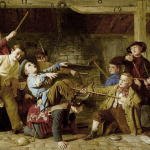 Movies and TV
Movies and TV  Movies and TV
Movies and TV  Animals
Animals The 10 Weirdest Octopuses In The Ocean
 Humans
Humans 10 Nifty Things Neanderthals Did That Wows Modern Humans
 Movies and TV
Movies and TV 10 Mind-Bending Psychological Thrillers From The 90s That Still Haunt Us Today
 Technology
Technology 10 Amazing Technologies That Used to Be Awfully Inefficient
 Mysteries
Mysteries The Top 10 Military UFO Sightings That Remain Unexplained
 Politics
Politics 10 People Who Secretly Controlled Countries Without a Title
 Movies and TV
Movies and TV 10 Horror Movies That Take Place Mostly During The Day
 Humans
Humans Seeing the More Human Side of Ten People We Grew Up Watching
 Health
Health Ten Shocking Facts About Forever Chemicals
 Movies and TV
Movies and TV 10 Animated TV Shows With Surprisingly Dark Origin Stories
 Animals
Animals The 10 Weirdest Octopuses In The Ocean
 Humans
Humans 10 Nifty Things Neanderthals Did That Wows Modern Humans
Who's Behind Listverse?

Jamie Frater
Head Editor
Jamie founded Listverse due to an insatiable desire to share fascinating, obscure, and bizarre facts. He has been a guest speaker on numerous national radio and television stations and is a five time published author.
More About Us Movies and TV
Movies and TV 10 Mind-Bending Psychological Thrillers From The 90s That Still Haunt Us Today
 Technology
Technology 10 Amazing Technologies That Used to Be Awfully Inefficient
 Mysteries
Mysteries The Top 10 Military UFO Sightings That Remain Unexplained
 Politics
Politics 10 People Who Secretly Controlled Countries Without a Title
 Movies and TV
Movies and TV 10 Horror Movies That Take Place Mostly During The Day
 Humans
Humans Seeing the More Human Side of Ten People We Grew Up Watching
 Health
Health Ten Shocking Facts About Forever Chemicals
10 Severely Twisted American Psychopath Parents Who Poisoned Children
Of all the ways one human can kill another, poisoning remains uniquely sinister. It is a crime of intimacy, a profound betrayal that takes the very act of caregiving and weaponizes it into an instrument of death. Historically, poison was the secret weapon of the cowardly and the patient, with arsenic, the “King of Poisons,” reigning supreme. Its symptoms mimicked common ailments like cholera, making it nearly undetectable for centuries and earning it a reputation as a woman’s tool and an inheritance powder.
While tales of poisoned Halloween candy largely remain the stuff of urban legend, designed to spook us during fearful times, the reality of child poisoning in America is far more horrifying because the monster is almost never a stranger. The true threat lurks within the home, wielded by the very hands meant to protect.
Please read on to find out just how terribly the trust we depend on as children can be shattered. (Note: Eight of the ten psychopaths listed below were mothers—and most murdered not only other people’s children but their own as well.)
Related: Ten 21st-Century American Serial Killers Who Got Away with It
10 Sarah Jane Whiteling–The Victorian Mother and Her Favorite Rat Poison
In 1888 Philadelphia, Sarah Jane Whiteling (1848–1889) became a media sensation, a real-life monster for an era that consumed such stories with morbid glee. Over several months, she methodically poisoned her husband John, her nine-year-old daughter Bertha, and her two-year-old son Willie. Her weapon of choice was “Rough on Rats,” a common household pesticide laced with arsenic. The motive was as chilling as it was simple—a small amount of life insurance money.
The case serves as a fascinating benchmark in the history of crime. It relied on the emerging science of forensic toxicology, with a chemist confirming the presence of arsenic in the exhumed remains of all three victims. This scientific certainty stood in stark contrast to the era’s primitive understanding of psychology. The press, tapping into deep-seated fears about female transgression, dubbed Whiteling the “modern Borgia,” framing her as an unnatural mother and a “female fiend.”
Perhaps the most bizarre aspect of the case was the defense mounted by Dr. Alice Bennett, one of the first female physicians to run an asylum. She argued that Whiteling was not evil but insane, proposing a theory that her actions were the result of a “nerve explosion” brought on by the physical and mental strain of her menstrual cycle and a fear of pregnancy. This early, if unsuccessful, attempt at a medico-legal defense based on female physiology was drowned out by public outrage. The jury sided with the prosecution, and Sarah Jane Whiteling was hanged, her case forever cementing the archetype of the cold-blooded female poisoner in the American consciousness.[1]
9 Ronald O’Bryan–The Man Who Killed Halloween
Every Halloween, parents inspect their children’s candy, wary of the urban legend of the stranger handing out poisoned treats. That pervasive fear has a face—Ronald O’Bryan (1944–1984), the “Candyman.” On Halloween night 1974, O’Bryan, a Texas man in severe debt, gave cyanide-laced Pixy Stix to five children. One of those children was his own eight-year-old son, Timothy, who ate the candy and died a short time later.
O’Bryan’s crime was not the random act of a madman that he intended it to appear. It was a cold, calculated plot to murder his own son in order to collect on a recently acquired life insurance policy. The true darkness of his plan lies in the collateral damage he was willing to inflict to create his cover story. He gave the poisoned candy not only to his son but also to his daughter and three other neighborhood children. He callously gambled with four other young lives simply to make his son’s death look like part of a random “Halloween sadism” event. Fortunately, none of the other children ate the lethal candy.
Investigators quickly saw through the ruse, and O’Bryan was convicted and executed in 1984. His crime, however, had a lasting legacy. He single-handedly cemented the myth of poisoned Halloween candy in the American psyche. The real horror—a father murdering his son for money—was so specific and monstrous that it birthed a general, and largely baseless, fear that has tainted a childhood tradition for decades.[2]
8 Anjette Lyles–The Restaurant Owner with a Morbid Taste for Arsenic
In 1950s Macon, Georgia, Anjette Lyles’s restaurant was the place to be. She was a seemingly glamorous and popular figure, greeting customers with warm hugs and lively conversation, but behind the charming façade of the successful restaurateur was a cold-blooded killer. Over a period of six years, Lyles (1925–1977) poisoned her first husband, Ben Lyles; her second husband, Joe Neal Gabbert; her mother-in-law, Julia Lyles—and her own nine-year-old daughter, Marcia.
Her motive was simple greed. With each death, she collected insurance money, which she reportedly spent like a “drunken sailor,” buying herself a new white Cadillac after her second husband’s death. Her method was arsenic, likely from Terro Ant Killer, administered in small, repeated doses disguised in the very food and drink that made her restaurant so popular.
What made the case a national sensation was the discovery of voodoo paraphernalia in her home. Investigators found black candles, potions, and powders, adding a layer of folk-magic horror to the story. During her trial, Lyles remained cool and unemotional, clutching a small white Bible, creating a disturbing tableau of piety and alleged witchcraft.
Though sentenced to death, she was later deemed insane by psychologists and sent to a state hospital. In a final, creepy twist of fate, the woman who poisoned her family through food reportedly spent the rest of her life working in the hospital kitchen.[3]
7 Rhonda Belle Martin–The Waitress Who Served Death
For some killers, the motive isn’t money or revenge, but something far more narcissistic and strange. For Rhonda Belle Martin (1907–1957), a waitress from Montgomery, Alabama, the payoff was sympathy. Active from the 1930s to the 1950s, Martin poisoned her mother, two husbands, and three of her children—three-year-old Emogene, six-year-old Carolyn, and eleven-year-old Ellyn. Her weapon was arsenic-laced rat poison.
While prosecutors initially suspected a financial motive, the insurance payouts were minimal, barely covering burial costs. The truth of her psychology was revealed in her confession. According to a LIFE Magazine article from the era, Martin admitted she “loved getting the get-well cards, and later the sympathy cards, that came when the victims died.” She was a “public griever,” a killer who derived emotional gratification from the attention and pity of others. She even took careful planning to have her victims buried side-by-side in a private plot, creating a ghastly monument to her need for attention.
Her most twisted act reveals the depth of her pathology. After murdering her fourth husband, Claude Martin, she married his son, Ronald—her own stepson. She then proceeded to poison him as well, leaving him a paraplegic. It was his illness that finally led authorities to investigate the string of deaths surrounding Rhonda. This willingness to incestuously weave herself into the next generation of a family she was actively destroying showcases a rare and profoundly disturbing need to maintain control over her tragic narrative.[4]
6 Diane Staudte–The Antifreeze Family Plot
Some murders are born of high passion or deep psychosis. Others, more chillingly, are born of simple annoyance. In 2012, Diane Staudte (1968– ), a church organist and mother from Springfield, Missouri, decided to do some housecleaning. Aided by her favorite daughter, Rachel, she began to eliminate family members she found burdensome.
Her husband, Mark, was the first to go. Diane claimed she “hated his guts” and found him lazy. Five months later, her 26-year-old autistic son, Shaun, was killed because he was “worse than a pest.” Next on the list was her 24-year-old daughter, Sarah, who was a burden because of her unpaid student loans. Diane and Rachel poisoned them by mixing antifreeze into their Gatorade and soda. They specifically bought the poison online to ensure it lacked the bittering agent added to store-bought products, making it impossible to taste.
The plot was only discovered when the family’s pastor, disturbed by Diane’s complete lack of emotion at the funerals, made an anonymous tip to the police after Sarah was hospitalized with organ failure. The most horrifying evidence came from Rachel’s diary, where she had chillingly written, “It’s sad when I realize how my father will pass on in the next two months… Shaun, my brother, will move on shortly after.” Diane was sentenced to life without parole—Rachel received two life sentences.[5]
5 Judy Buenoano–The Black Widow’s Drowning Deceit
Dubbed Florida’s “Black Widow,” Judy Buenoano (1943–1998) was a prolific and adaptable killer who murdered for insurance money. Her victims included her husband, a boyfriend, and her own son, Michael. While her primary method was poison, her son’s murder revealed a particularly cruel and calculating mind willing to escalate her methods with terrifying creativity.
In 1979, Buenoano began poisoning her son, Michael, with arsenic. The poison didn’t kill him, but it did leave him a paraplegic, forced to wear heavy metal braces on his legs and arms. For most killers, this might be considered a failure. For Buenoano, it was an opportunity. On May 13, 1980, she took her disabled son on a canoe trip. Once out on the water, she deliberately capsized the boat. Weighed down by the very braces his poison-induced disability required, Michael sank and drowned.
This two-stage murder is what sets Buenoano apart. She didn’t just try again with more poison—she used the consequences of her first failed murder attempt as the very instrument of her second, successful one. This escalation from the covert violence of poison to the overt brutality of drowning demonstrates a horrifying pragmatism.
When a later boyfriend, John Gentry, survived her attempts to poison him with paraformaldehyde-laced “vitamins,” she escalated again, planting a bomb in his car. Judy Buenoano wasn’t just a poisoner—she was a multifaceted killer who saw poison as just one tool in a toolbox full of deadly solutions for her financial problems.[6]
4 Lacey Spears–The Mommy Blogger Murderer
The case of Lacey Spears (1987– ) is a chilling story of Munchausen by Proxy for the 21st century. The psychological disorder, in which a caregiver fabricates or induces illness in a dependent to gain attention and sympathy, has found a powerful new stage in the age of social media. Spears, a young mother from New York, didn’t just crave the attention of doctors—she cultivated an entire online audience.
For years, Spears obsessively documented the supposed chronic illnesses of her son, Garnett, on a blog and social media platforms like Facebook and Twitter. She posted heart-wrenching photos and dramatic updates, performing the role of a devoted, long-suffering mother. Hundreds of followers offered prayers and sympathy, validating the narrative she was carefully crafting. All the while, she was the one making him sick.
In 2014, five-year-old Garnett died. The cause was acute sodium poisoning. Investigators discovered that Spears had been force-feeding her son lethal concentrations of salt through his stomach feeding tube. The digital trail she had so meticulously created to chronicle her “care” became the primary evidence of her abuse. Every post begging for support, every photo of Garnett in a hospital bed, was a record of her deception.
Convicted of murder, Spears still maintains her innocence and blames the hospital—a common tactic for perpetrators of this disorder. Her case reveals how the internet can amplify these situations, providing a constant stream of the attention these individuals crave.[7]
3 Nannie Doss–The Giggling Granny
With a cheerful disposition that earned her the nickname “The Giggling Granny,” Nannie Doss (1905–1965) seemed like the last person who could be a serial killer. Yet between the 1920s and 1954, she murdered at least 11 family members across several states. Her victims included four of her five husbands, her mother, her sister, a mother-in-law, and most horrifically, two of her own daughters and two infant grandsons. Her method was usually arsenic, often baked into a prune pie or stirred into coffee.
Doss’s motive was one of the most unusual in the history of American crime. She wasn’t driven by money, though she did collect insurance policies. She was driven by a delusional, lifelong quest for the “perfect love” she read about in her favorite romance magazines. When her real-life husbands inevitably disappointed her and failed to live up to her fictional ideals, she simply killed them and moved on to the next, hoping to finally find her “true love.” The children and other relatives were dispatched when they became inconvenient or stood in the way of her romantic fantasies.
The most disturbing and mysterious detail of her crimes emerged from the death of one of her newborn grandsons. Her daughter, Melvina, exhausted and groggy from childbirth, later recalled seeing her mother stick a hatpin into the baby’s head. While never proven, this account suggests a capacity for direct, impulsive violence that goes beyond the patient methodology of a poisoner, hinting at a darker rage simmering just beneath the giggling façade.[8]
2 Marybeth Tinning–The Mother of Lost Children
The case of Marybeth Tinning (1942– ) is a staggering chronicle of both maternal malice and systemic failure. Between 1972 and 1985, all nine of her children—eight biological and one adopted—died before the age of five. For thirteen years, a child died in her care approximately every 16 months, yet the pattern went officially unrecognized.
While Tinning was only convicted for the 1985 murder of her ninth child, Tami Lynne, whom she smothered with a pillow, she confessed to killing two of her sons as well. Her history with poison was established early in her marriage when she tried to kill her husband, Joe, by putting barbiturates in his grape juice. This willingness to use poison, combined with the string of inexplicable child deaths, points to a clear pattern of Munchausen by Proxy, where she craved the attention and sympathy that came with having a sick or dying child.
The most horrifying aspect of the case is how she remained undetected for so long. Doctors repeatedly attributed the deaths to Sudden Infant Death Syndrome (SIDS) or a mysterious, undiscovered genetic flaw. This diagnosis was shattered when her adopted son, Michael, also died, proving the problem was not genetic. Yet still, no one intervened. The Tinning case stands as a powerful indication of a medical and social system blinded by the assumption that a mother could never harm her child, allowing a serial killer to operate with impunity for over a decade.[9]
1 Genene Jones–The Angel of Death and Her ICU
The top spot on this list belongs to the woman who represents the ultimate betrayal of trust in the most vulnerable of settings. Genene Jones (1950– ), a licensed vocational nurse in Texas, turned the pediatric intensive care unit—a place of healing—into her personal hunting ground. While convicted of murdering only one infant, Chelsea McClellan, she is suspected of being responsible for the deaths of up to 60 babies and children during the 1970s and 1980s.
Jones’s motive was a twisted variant of Munchausen by Proxy known as a “hero complex.” She would secretly inject her tiny patients with powerful drugs like the muscle relaxant succinylcholine or the heart medication digoxin. This would induce a catastrophic medical crisis, like respiratory or cardiac arrest. Jones would then be the first to sound the alarm, hoping to “save” the child and be lauded as a hero by doctors and frantic parents. Many of her “rescues” failed.
The most sinister part of the story is the alleged institutional cover-up. At Bexar County Hospital, officials noted a statistically impossible number of deaths occurring on Jones’s shift. Fearing lawsuits and bad publicity, hospital administrators didn’t go to the police. Instead, they allegedly destroyed records and simply asked Jones and all other LVNs in the unit to resign, providing her with a clean slate to get a job at a private pediatric clinic in Kerrville, where she killed again. Genene Jones is number one not just for her staggering potential body count, but because her case exposes how a medical professional’s specialized knowledge and an institution’s cowardice can combine to create the perfect, unstoppable predator.[10]








